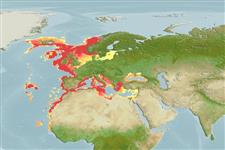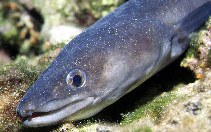Adicionar sua observação em Fish Watcher
| Native range | All suitable habitat | Point map | Year 2050 |

|
| This map was computer-generated and has not yet been reviewed. |
| Conger conger AquaMaps Data sources: GBIF OBIS |
Carregue seu(sua) Fotos e vídeos
Pictures | Videos | Imagem do GoogleConger conger
Picture by Patzner, R.
Pictures | Videos | Imagem do GoogleConger conger
Picture by Patzner, R.
France country information
Common names:
Anguille de mer, Congre, Coungre nègre
Occurrence: native
Salinity: marine
Abundance: | Ref:
Importance: commercial | Ref: FAO, 1994
Aquaculture: | Ref:
Regulations: | Ref:
Uses: live export: yes;
Comments: Known from the Gironde estuary (Ref. 51442).
National Checklist:
Country Information: https://www.cia.gov/library/publications/resources/the-world-factbook/geos/fr.html
National Fisheries Authority:
Occurrences: Occurrences Point map
Main Ref: Béarez, P., P. Pruvost, É. Feunteun, S. Iglésias, P. Francour, R. Causse, J. De Mazières, S. Tercerie and N. Bailly, 2017
National Database:
Occurrence: native
Salinity: marine
Abundance: | Ref:
Importance: commercial | Ref: FAO, 1994
Aquaculture: | Ref:
Regulations: | Ref:
Uses: live export: yes;
Comments: Known from the Gironde estuary (Ref. 51442).
National Checklist:
Country Information: https://www.cia.gov/library/publications/resources/the-world-factbook/geos/fr.html
National Fisheries Authority:
Occurrences: Occurrences Point map
Main Ref: Béarez, P., P. Pruvost, É. Feunteun, S. Iglésias, P. Francour, R. Causse, J. De Mazières, S. Tercerie and N. Bailly, 2017
National Database:
Common names from other countries
Classificação / Names Nomes comuns | Sinônimos | Catalog of Fishes(Gênero, Espécies) | ITIS | CoL | WoRMS | Cloffa
> Anguilliformes (Eels and morays) > Congridae (Conger and garden eels) > Congrinae
Etymology: Conger: Latin, conger = conger (Ref. 45335).
More on author: Linnaeus.
Etymology: Conger: Latin, conger = conger (Ref. 45335).
More on author: Linnaeus.
Environment: milieu / climate zone / depth range / distribution range Ecologia
marinhas demersal; oceanódromo (Ref. 51243); intervalo de profundidade 0 - 1171 m (Ref. 56504). Temperate; 68°N - 12°N, 32°W - 42°E
Distribuição Países | Áreas da FAO | Ecossistemas | Ocorrências | Point map | Introduções | Faunafri
Eastern Atlantic: Norway and Iceland to Senegal. Also in the Mediterranean and Black Sea.
Comprimento de primeira maturação / Tamanho / Peso / Idade
Maturity: Lm 200.0 range ? - ? cm
Max length : 300 cm TL macho/indeterminado; (Ref. 4453); common length : 100.0 cm TL macho/indeterminado; (Ref. 4645); common length :150 cm TL (female); peso máx. publicado: 110.0 kg (Ref. 35388)
Max length : 300 cm TL macho/indeterminado; (Ref. 4453); common length : 100.0 cm TL macho/indeterminado; (Ref. 4645); common length :150 cm TL (female); peso máx. publicado: 110.0 kg (Ref. 35388)
Found on rocky and sandy bottoms (Ref. 12382). Depth range from 0-500 m (Ref. 4453) and from 305-1171 m in the eastern Ionian Sea (Ref. 56504). It stays near the coast when young and moves toward deeper waters upon reaching adulthood (Ref. 5377). A nocturnal (Ref. 12382) predator of fish, crustaceans, and cephalopods (Ref. 6521). Like other species of the group, it reproduces only once in its life (Ref. 5377). Sexually mature at an age of 5-15 years. Spawn in summer in the Atlantic off Portugal and in the Mediterranean. Produces 3-8 million of eggs (Ref. 35388). Marketed fresh and frozen. Eaten fried and baked (Ref. 9988).
Ciclo de vida ou comportamento de acasalamento Maturidade | Reprodução | Desova | Ovos | Fecundidade | Larvas
Eggs are deposited in the open sea, at depths between 2,000 and 3,000 m (Ref. 12382).
Referência principal
Upload your references | Referências | Coordenador | Colaboradores
Smith, D.G., 1990. Congridae. p. 156-167. In J.C. Quero, J.C. Hureau, C. Karrer, A. Post and L. Saldanha (eds.) Check-list of the fishes of the eastern tropical Atlantic (CLOFETA). JNICT, Lisbon; SEI, Paris; and UNESCO, Paris. Vol. 1. (Ref. 4453)
Status na Lista Vermelha da UICN (Ref. 130435: Version 2024-2)
Segura ou pouco preocupante (LC) ; Date assessed: 20 October 2011
Uso pelos humanos
Pescarias: espécies comerciais; peixe esportivo: sim; Aquário: Aquários públicos
FAO(pescarias: produção, perfil da espécie; publication : search) | FishSource | Sea Around Us
Mais informação
Population dynamics
Parâmetros de crescimento
Max. ages / sizes
Length-weight rel.
Length-length rel.
Frequências de comprimento
Conversão de massa
Recrutamento
Abundância
Parâmetros de crescimento
Max. ages / sizes
Length-weight rel.
Length-length rel.
Frequências de comprimento
Conversão de massa
Recrutamento
Abundância
Life cycle
Reprodução
Maturidade
Fecundidade
Desova
Spawning aggregations
Ovos
Desenvolvimento dos ovos
Larvas
Dinâmica larval
Reprodução
Maturidade
Fecundidade
Desova
Spawning aggregations
Ovos
Desenvolvimento dos ovos
Larvas
Dinâmica larval
Physiology
Body composition
Nutrients
Consumo de oxigênio
Tipo de natação
Velocidade de natação
Visual pigments
Fish sound
Diseases & Parasites
Toxicity (LC50s)
Body composition
Nutrients
Consumo de oxigênio
Tipo de natação
Velocidade de natação
Visual pigments
Fish sound
Diseases & Parasites
Toxicity (LC50s)
Human related
Aquaculture systems
Perfis para aquacultura
Estirpes
Ciguatera cases
Stamps, coins, misc.
Aquaculture systems
Perfis para aquacultura
Estirpes
Ciguatera cases
Stamps, coins, misc.
Ferramentas
Bio-Quiz | Livro eletrônico | Guia de campo | Ferramenta auxiliar de frequências de comprimento | Ferramenta sobre a história de vida | Mapa de pontos | Classification Tree
| Catch-MSY |
Relatórios especiais
Checar Manutenção em Aquário | Checar Planilhas de Fatos sobre as Espécies | Checar Planilhas de Fatos sobre Aquicultura
Baixar XML
Fontes da internet
Aquatic Commons | BHL | Cloffa | Websites from users | Checar Observador de Peixes (FishWatcher) | CISTI | Catalog of Fishes(Gênero, Espécies) | DiscoverLife | DORIS | ECOTOX | Faunafri | Fishtrace | GenBank(genoma, nucleotídeo) | GloBI | GOBASE | | Google Books | Google Scholar | Google | IGFA World Record | MitoFish | Bases de dados nacionais | OsteoBase(skull, spine) | Otolith Atlas of Taiwan Fishes | Aquários públicos | PubMed | Reef Life Survey | Scirus | SeaLifeBase | Árvore da vida | Wikipedia(Ir para, procura) | World Records Freshwater Fishing | Registro zoológico
Estimates based on models
Preferred temperature (Ref. 115969): 4.4 - 14.4, mean 8.7 (based on 480 cells).
Índice de diversidade filogenética (Ref. 82804): PD50 = 0.5000 [Uniqueness, from 0.5 = low to 2.0 = high].
Bayesian length-weight: a=0.00046 (0.00035 - 0.00059), b=3.26 (3.20 - 3.32), in cm Total Length, based on LWR estimates for this species (Ref. 93245).
Nível Trófico (Ref. 69278): 4.3 ±0.4 se; based on diet studies.
Resiliência (Ref. 120179): Baixo, tempo mínimo de duplicação da população 4,5 - 14 anos (K=0.06; tm=5-15 (female tm>10); Fec=3,000,000).
Prior r = 0.35, 95% CL = 0.23 - 0.53, Based on 7 data-limited stock assessments.
Fishing Vulnerability (Ref. 59153): Very high vulnerability (86 of 100).
Climate Vulnerability (Ref. 125649): Moderate vulnerability (38 of 100).




